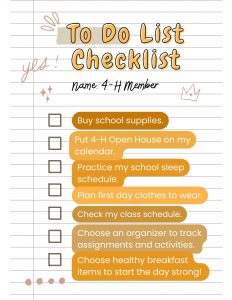Tips to Help Youth and Families Handle Back-to-School Stress
While returning to school may be exciting to some children, for others the back-to-school season is a time of anxiety and heightened stress. Whether you are a parent or an adult who works closely with youth, there are steps to take that can help young people manage stress and build a foundation for school success.
In my role with 4-H, I serve as a member of University of Florida faculty specializing in youth development and volunteer systems in the Wakulla County Extension office. My work involves collaborating with and supporting local youth, their families, adult volunteers, and community partners. This summer, I completed Mental Health First Aid Training, a program offered by the National Council for Mental Wellbeing. This training is available to any interested adult or teen. Visit this site for more information: https://www.mentalhealthfirstaid.org/. The training was an excellent refresher that helped bring me up to date on ways to support youth and families in our community. Mental health concerns often differ by age. What may be worrisome to your elementary school aged child has will likely differ from what will trouble your high school aged teen.
Getting the Conversation Started
Over the course of twenty-eight years and counting as an educator, I have had the opportunity to work with youth and young adults ranging from pre-school to college. The one concern I can confidently say that
youth of any age are likely to share is a fear of the unknown. While the unknowns change from year to year and differ between children, one way to handle potential worries is to talk about them. Consider these conversation starters to help your child discuss the new school year:
- What do you most look forward to experiencing/doing this school year?
- If you could change one thing about the last school year, what would it be? Why?
- What are you most hoping to learn/do this school year?
While some children will take these questions and run with them, other children may be less eager to communicate or just less enthusiastic about the new year. Parents may want to adjust their questions to address stressors that accompany back to school time and how to alleviate those concerns.
Tips for the Early Years of Elementary School
For younger children, driving by the school building may help alleviate nerves. You may not get to visit a classroom inside the school until a scheduled Open House event, but seeing the place and discussing what the school day involves can help to dispel some worry. Tips for easing the back-to-school jitters for elementary school:
- Establish the back-to-school bedtime routine. Helping to get sleep routines back on the school year schedule is a good first step to success.
- Practice the morning routine. Consider timing it. Make it a game. What steps are needed to get everyone out the door on time? Practicing this routine for a few days will help everyone make better school day decisions such as whether to lay out clothes and school supplies the night before, make lunch or snacks the night before, and can help everyone feel less stressed on school days.
- Plan for lunch and practice lunch time skills. If you are sending a packed lunch or snacks, can your child open the packages without help? Does your child like what you are sending? Involving children in planning lunch and snacks can help ensure food is eaten and not wasted.
The American Academy of Pediatrics offers helpful back to school tips for kindergarten through school on the HealthyChildren.Org page located at https://www.healthychildren.org/English/ages-stages/gradeschool/school/Pages/back-to-school-tips.aspx.
Tips to Manage Middle School
In middle school, school expectations for youth increase with each grade level. The Nemours Foundation offers advice specific to the middle school years:
- Visit the school website with your youth. Review school policies together.
- Discuss goals for the school year together. The middle school years offer opportunities to develop organizational skills and start to make choices about how to allocate their time.
- Work together to develop a realistic nutrition plan. Your middle school child may prioritize sleep over a healthy breakfast. Discussing your expectations about how and what your child eats to be well-prepared for the school will help ensure they can follow a plan that works for both of you.
For more tips about supporting your middle school student for success, visit the Nemours Kids Health web page at https://kidshealth.org/en/parents/school-help-middle.html.
Tips to Finish Strong in High School
The high school years come with a different set of stressors and the concerns your child has entering ninth grade will likely be different than the concerns they have entering senior year. For youth entering the ninth grade, high school may seem intimidating. Youth have experienced the heights of eighth grade, when they are the oldest in middle school. Then, ninth grade rolls around and students are back on the lowest rungs of the school pecking order once again. Add the pressure of an environment where grades and extracurricular activities may impact a child’s future beyond the high school years and the perfect formula for stress is created. How can parents support a newly minted high school student?
- Discuss course choices with the school course catalog as a guide. The school guidance counselor can help you locate the guide if it is not available on the school website.
- Determine what goals your child want to set. Do they want to take a language, join a school club, try out for a sport?
- Is your child leaning toward vocational studies? What requirements do they need to fulfill to enter a vocational program?
Setting academic and post-high school goals as early as eighth or ninth grade can help alleviate some stress in the final years of high school. Youth in tenth and eleventh grades will either work to maintain a positive trajectory or they will need to do self-examination to determine how to get back on a track that will get them where they want to go. Youth at this age may be considering after-school jobs or may take advantage of dual enrollment course options.
Youth entering twelfth grade, along with their families, are about to embark on an emotional roller coaster ride. High school seniors and their parents will experience a number of “last time this will happen” moments, beginning with the first day of school. The final year of high school can be bittersweet. This last year will also carry the weight of the future with it. Some youth may find themselves overwhelmed by the unknowns and the many decisions that may be facing them as they prepare for a life beyond high school. To ease some of this stress, have family discussions about the school year before classes begin. Plan on check ins throughout the year. The emotions a student may feel in August may differ significantly from what they are feeling in February when peers begin to receive college acceptances. Possible questions to ask early in senior year:
- What deadlines should we have on our calendar?
- When are payments due for college applications, senior trips, cap and gown, invitations?
- What parts of senior year do you want family members to experience and what part of senior year will be just for you and your friends? This is the time to start planning for sports or band senior nights, gatherings for Homecoming or Prom, and graduation parties.
Handling Challenges and Opportunities Together
Whether you are the nervous parent of a kindergartener or the proud parent of a high school senior, the new school year will bring challenges to manage as well as opportunities to make new family memories. Planning ahead and keeping the lines of communication flowing between family members will help the school year flow more smoothly for parents and students alike. If you are looking for new youth or volunteer activities to add to your family’s routine this school year, consider contacting your local Extension office for youth activities and volunteer opportunities.
Additional Back-to-School Stress Management Resources
The American Institute of Stress. (2019). 15 Ways to Beat Back-to-School Stress. Retrieved July 25, 2023 from https://www.stress.org/15-ways-to-beat-back-to-school-stress.
Borenstein, J. (2019). Back-to-School Stress Management. Brain and Behavior Research Foundation.
Retrieved July 25, 2023 from https://www.bbrfoundation.org/blog/back-school-stress-management#:~:text=Each%20weekend%2C%20spend%20some%20time,likely%20to%20stick%20to%20them.
JED Foundation. (2023). 8 Ways to Lower Stress in High School. Retrieved July 25, 2023 from https://jedfoundation.org/resource/8-ways-to-lower-stress-in-high-school/.




